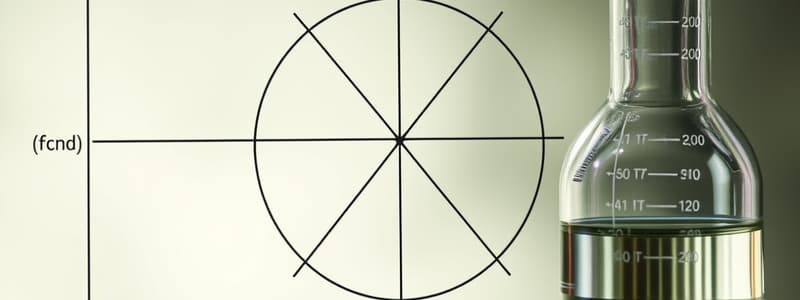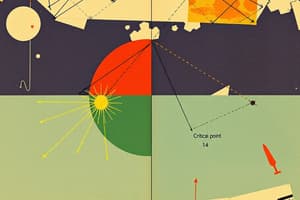Podcast
Questions and Answers
What is a phase diagram?
What is a phase diagram?
A phase diagram is a graphical representation of the physical states of a substance under different conditions of temperature and pressure.
Which of the following describes the three areas in a phase diagram?
Which of the following describes the three areas in a phase diagram?
- Solid, gas, and plasma
- Gas, plasma, and liquid
- Solid, liquid, and vapor (correct)
- Solid, liquid, and gas
The process of a solid turning into a liquid is called ______.
The process of a solid turning into a liquid is called ______.
melting
Carbon dioxide can exist as a liquid at atmospheric pressure.
Carbon dioxide can exist as a liquid at atmospheric pressure.
What are the types of phase changes?
What are the types of phase changes?
What does the green line in a phase diagram represent?
What does the green line in a phase diagram represent?
What is created when dry ice sublimates?
What is created when dry ice sublimates?
Match the phase changes with their descriptions:
Match the phase changes with their descriptions:
Flashcards are hidden until you start studying
Study Notes
Phase Diagrams
- A phase diagram visually represents the states of matter (solid, liquid, vapor) of a substance varying with temperature and pressure.
- Key regions in the diagram are marked as solid, liquid, and vapor, indicating equilibrium conditions for different phases.
Phase Changes
- Phase changes are transformations between different states of matter triggered by energy changes (usually heat).
- Common types of phase changes include:
- Melting: Solid to liquid
- Freezing: Liquid to solid
- Vaporization: Liquid to gas
- Condensation: Gas to liquid
- Sublimation: Solid to gas
- Deposition: Gas to solid
Importance of Crystalline and Amorphous Solids
- Understanding the differences between crystalline (ordered structure) and amorphous solids (disordered structure) is crucial in various daily applications and material science.
Carbon Dioxide Behavior
- Carbon dioxide cannot exist as a liquid at atmospheric pressure, leading to its sublimation into gas directly from solid dry ice, creating fog due to condensation of water vapor.
Colligative Properties
- Colligative properties depend on the number of solute particles in a solution, affecting boiling point elevation and freezing point depression.
- Differentiate between the colligative properties of nonelectrolyte solutions (do not dissociate) and electrolyte solutions (dissociate into ions).
Concentrations of Solutions
- Concentration can be expressed as:
- Percent by mass
- Mole fraction
- Molarity (moles of solute per liter of solution)
- Molality (moles of solute per kilogram of solvent)
- Percent by volume
- Parts per million (ppm)
Stoichiometry in Solutions
- Perform stoichiometric calculations involving moles of reactants and products to understand reactions in solution.
Laboratory Procedures
- Learning proper laboratory methods for determining solution concentrations is vital for accurate results in experiments.
Studying That Suits You
Use AI to generate personalized quizzes and flashcards to suit your learning preferences.




